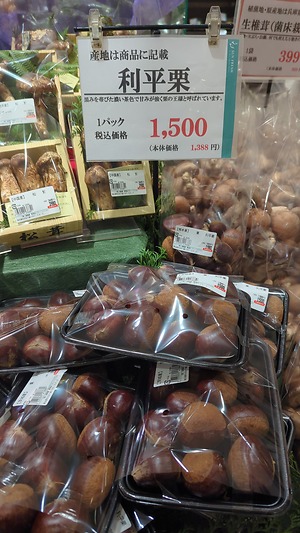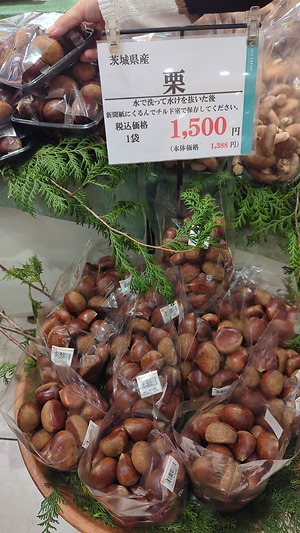


Japanese Chestnuts
Estimated Inventory, lb : 0
Description/Taste
Japanese chestnuts are encased in an outer, green-brown husk known as a bur, which is round to oval in shape and is covered in a layer of interlocking spines. When the bur is removed, an additional shell is revealed, enclosing 1 to 3 seeds that average 5 to 7 centimeters in diameter. The seeds are covered in a thin, brown skin and have a yellow, soft, and dense flesh with a slightly bitter flavor. Japanese chestnuts develop a tender, starchy, and firm consistency when cooked with a sweet and nutty flavor.
Seasons/Availability
Japanese chestnuts are available in the fall through winter.
Current Facts
Japanese chestnuts, botanically classified as Castanea crenata, are sweet, starchy seeds that belong to the Fagaceae or Beech family. Also known as Kuri in Japan, Japanese chestnuts are a highly prized, seasonal ingredient that has been consumed on the island nation for thousands of years. Chestnut trees frequently appear in myths and legends of Japanese folklore, and the seeds were often seen as a rich source of nutrients during the fall and winter season in ancient times. In the modern-day, Japanese chestnuts are still favored for their nutty flavor and are utilized in both savory and sweet applications. Japanese chestnuts are also known for their resistance to common diseases such as blight fungus. Many of these diseases plague American and European chestnut cultivars, and modern plant breeding programs are using Japanese chestnuts to create improved cultivars.
Nutritional Value
Japanese chestnuts are an excellent source of copper, magnesium, and manganese. The nuts are also a good source of vitamin C, which is an antioxidant that protects the body against environmental aggressors by boosting the immune system and contains some potassium, fiber, iron, and phosphorus.
Applications
Japanese chestnuts are best suited for cooked applications such as boiling, roasting, and steaming. The nuts hold their shape well when steamed or baked and are a popular filling for pancakes, dumplings, jellies, cakes, bread, and pastries. In Japan, chestnuts are used to prepare many regional specialties such as kurigoan, or steamed rice and chestnuts, and kurimanju, which is chestnut ravioli. During the New Year celebration, chestnuts are also popularly served candied with sweet potatoes in a dish known as kurikinton, which translates to mean “chestnut gold mash.” Consuming kurikinton during the celebration is supposed to ensure good luck and prosperity in the New Year. Japanese chestnuts are also popularly used to create mont blanc, which are chestnuts pureed with cream and sugar and piped onto a cupcake. Mont blanc cupcakes are extremely time-consuming to make, fetching high prices in the market, but despite the luxury price tag, they continue to be one of the most popular chestnut-flavored desserts in Japan. Japanese chestnuts pairs well with red bean, vanilla, cinnamon, whipped cream, chocolate, dried fruit, mushrooms, sweet potatoes, ginger, and rice. Fresh chestnuts will keep up to one week when stored in a sealed container in the refrigerator.
Ethnic/Cultural Info
Chestnuts are widely loved across Japan and are considered to be one of the most ancient seeds still in cultivation in the modern-day. When the nuts are in-season in the fall and winter, many Japanese fondly recall purchasing roasted chestnuts at train stations. The nuts are cooked in pots over tiny pebbles and are sold in bags that travelers can take with them on the train. Roasted chestnuts are especially popular with young children as they enjoy peeling the nuts and consuming the sweet, nutty seeds. In addition to street vendors, Japanese chestnuts are celebrated at many festivals across Japan. In Okunitama Jinja, one of the oldest shrines in Tokyo, the festival Kuri matsuri is held every September and celebrates chestnuts while also showcasing dance performances, lanterns, and artwork. During the festival, many street chefs cook chestnuts into baked goods, rice dishes, and pastries, and the chestnut-flavored dishes are consumed while watching floats parade down the street.
Geography/History
Japanese chestnuts are native to Japan and the Korean peninsula, where they have been growing wild since ancient times. Chestnuts began to be commercially cultivated in Japan in the 11th century and are primarily grown in the Ehime, Ibaraki, and Kumamoto prefectures. Japanese chestnuts are also cultivated in Taiwan, China, and Korea, and in addition to growing the seeds, Japan is considered to be one of the largest importers of chestnuts from China to meet increasing demand. Today Japanese chestnuts can be found at local markets in Europe, China, Japan, Taiwan, New Zealand, and the United States.
Recipe Ideas
Recipes that include Japanese Chestnuts. One
| La Fuji Mama |
|
Japanese Chestnut Rice |
| Japan Centre |
|
Japanese Kuri Youkan Chestnut Jelly Cake |
| Just One Cookbook |
|
Chestnut Rice (Kuri Gohan) |
| Food & Wine |
|
Japanese Chestnut Tea Cake |









